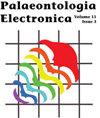Biostratigraphy and biochronology of late Cenozoic North American rodent assemblages
IF 1.5
4区 地球科学
Q1 Earth and Planetary Sciences
引用次数: 0
Abstract
Late Cenozoic rodent assemblages from western North America were added to a previous database limited to the central and eastern United States to develop a continental correlational system for the past 5 million years. Three hundred and twelve species representing 124 rodent assemblages were included, from which 12 Cenozoic Mammal Zones (CMZs) were constructed. Replacement chronologies for rodent assemblages based upon superposition, radiometric dates, paleomagnetic profiles, and evolutionary stages of dentitions from various depositional basins formed the skeleton for the chronological ordering of assemblages, and those lacking one or more information sources were sequenced based upon greatest concordance with available data. Arvicoline cricetids provided the most useful information for sequencing assemblages, followed by neotomine and sigmodontine cricetids and geomyids. The appearance of modern-sized cotton rats in CMZ 4, followed by the immigration of Allophaiomys across Beringia in CMZ 3, heralds the shift to the dominance of cotton rats and arhizodont voles in North American grassland ecosystems. No rapid bouts of significant turnover are associated with the beginning of the Pleistocene at 2.58 Ma (million years ago), but a pronounced turnover event was observed in the Meade Basin of southwestern Kansas immediately following the Huckleberry Ridge ash-fall at 2.07 Ma. Preliminary observations suggest two categories of rodent turnover; low-level background rotation determined by stochastic short-term regional and long-term global environmental change, and short-term turnover spikes mediated by catastrophic events such as volcanic eruptions.晚新生代北美啮齿动物组合的生物地层学和生物年代学
来自北美西部的晚新生代啮齿动物组合被添加到先前仅限于美国中部和东部的数据库中,以开发过去500万年的大陆相关系统。共纳入124个鼠类组合312种,构建了12个新生代哺乳动物区(CMZs)。基于迭加、放射性测年、古地磁剖面和不同沉积盆地齿列演化阶段的啮齿动物组合替代年代学,构成了组合年代学排序的骨架,而缺乏一个或多个信息源的序列则根据与现有数据的最大一致性进行排序。为测序组合提供了最有用的信息,其次是新托明和西莫顿汀。在CMZ 4中出现了现代大小的棉鼠,随后在CMZ 3中Allophaiomys跨越白令陆桥的迁移,预示着北美草原生态系统中棉鼠和arhizo不田鼠的优势地位的转变。在2.58 Ma(百万年前)更新世开始时,并没有出现重大的快速更替,但在2.07 Ma哈克贝利岭灰烬坠落之后,在堪萨斯州西南部的米德盆地观测到一次明显的更替事件。初步观察表明,啮齿动物的更替分为两类;由随机短期区域和长期全球环境变化决定的低水平背景旋转,以及由火山爆发等灾难性事件介导的短期周转量峰值。
本文章由计算机程序翻译,如有差异,请以英文原文为准。
求助全文
约1分钟内获得全文
求助全文
来源期刊

Palaeontologia Electronica
地学-古生物学
CiteScore
3.60
自引率
0.00%
发文量
20
审稿时长
>12 weeks
期刊介绍:
Founded in 1997, Palaeontologia Electronica (PE) is the longest running open-access, peer-reviewed electronic journal and covers all aspects of palaeontology. PE uses an external double-blind peer review system for all manuscripts. Copyright of scientific papers is held by one of the three sponsoring professional societies at the author''s choice. Reviews, commentaries, and other material is placed in the public domain. PE papers comply with regulations for taxonomic nomenclature established in the International Code of Zoological Nomenclature and the International Code of Nomenclature for Algae, Fungi, and Plants.
 求助内容:
求助内容: 应助结果提醒方式:
应助结果提醒方式:


